Benefits of Headless CMS vs a Traditional CMS
The time to choose a headless CMS over a traditional monolithic solutions couldn't be more clear.
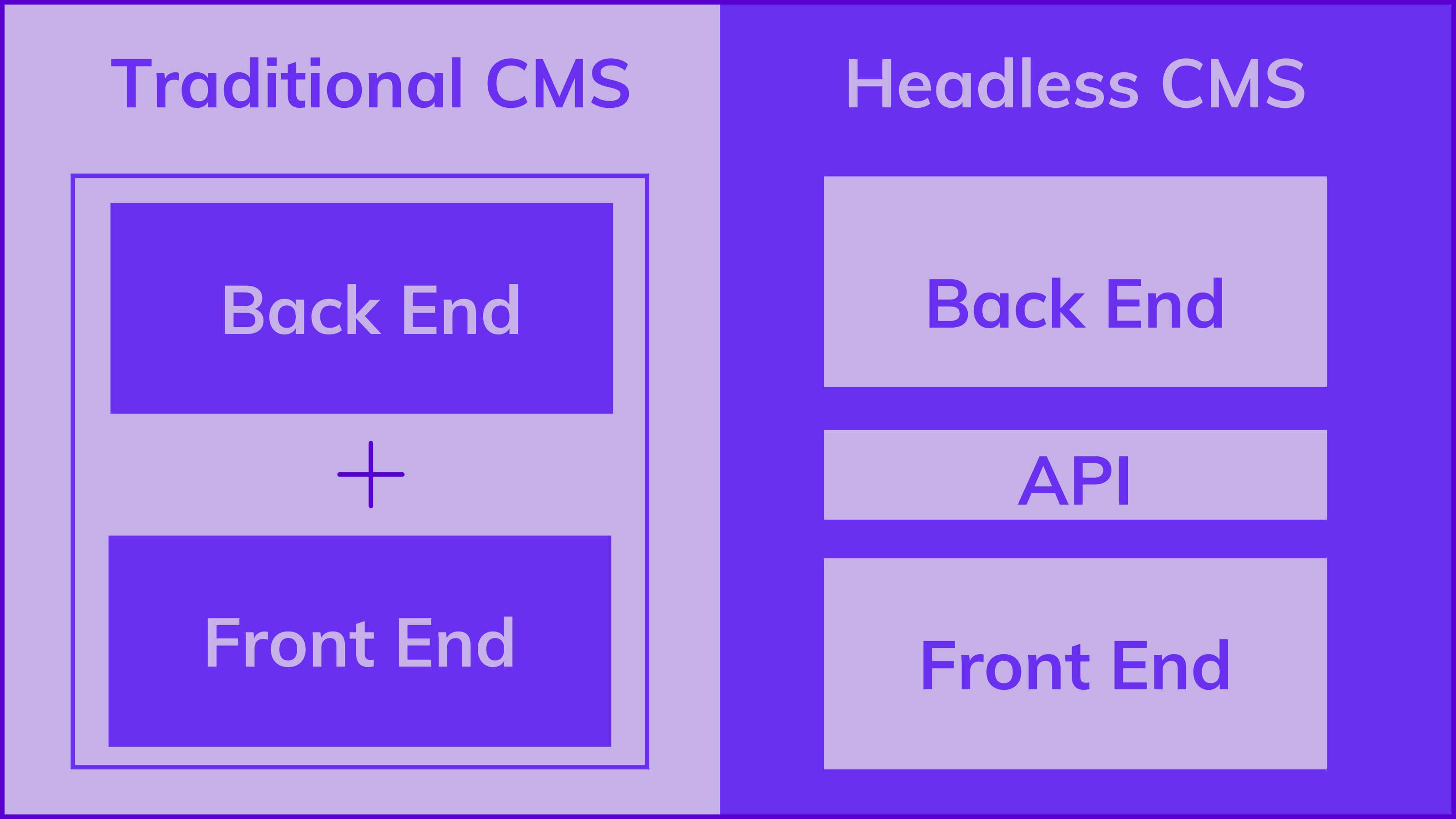
There are some very clear and obvious benefits to the notion of content management.
Traditional CMS vendors have praised those benefits for years and helped to bring on the initial web 2.0 revolution.
That was a long time ago, and while the tools and methodologies we use have undergone many stages of evolution and revolutions, the traditional CMS industry has not.
The time to choose a headless CMS over a traditional CMS couldn't be more clear. Let’s explore both options below and the top 10 considerations as to why you should consider going “headless.”
What is a Headless CMS?
Contrary to a traditional CMS, a headless CMS is entirely decoupled from the presentation layer/frontend, which is the “head,” and the backend is your content repository, known as the “body.”
When you separate your content repository “body” from its presentation layer “head,” it becomes a headless CMS.
What truly makes a headless CMS better than a traditional CMS is its content-first approach with full APIs to access and display content in any way desired. With this approach, a headless CMS enables you to author your content through the RESTful API and deliver it wherever you need.
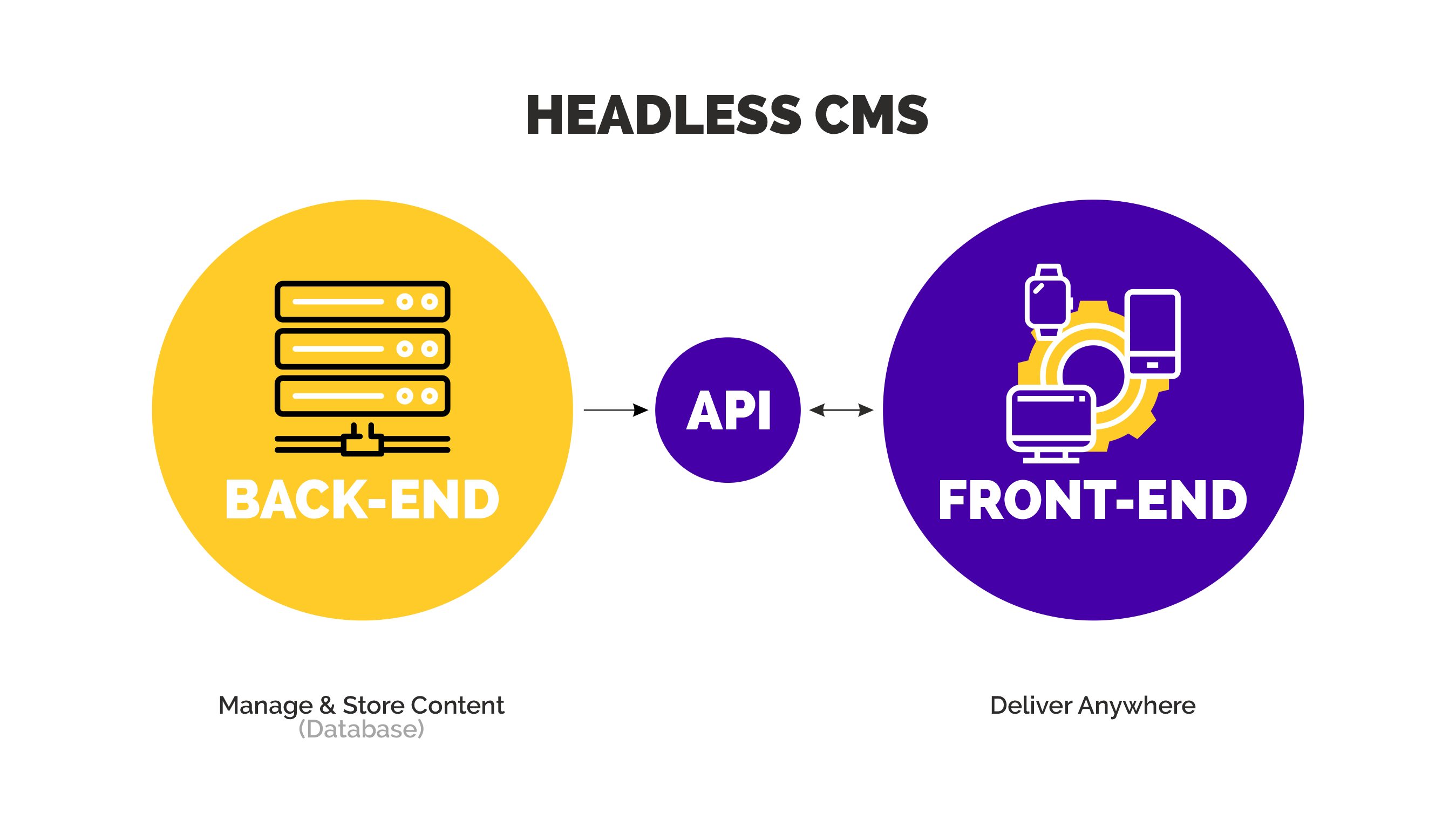
What is a Traditional CMS?
A traditional CMS is linked tightly between the front and back end. Content and all of your digital assets are created, managed, and stored on the site's back end.
The back end is also where website design and customization applications are stored. The content management back end and database are bound within the same system that delivers and presents content to devices and end-users (front end). Your editors are writing and publishing on the back end of the same system your website visitors are viewing. This can be a bit scary!
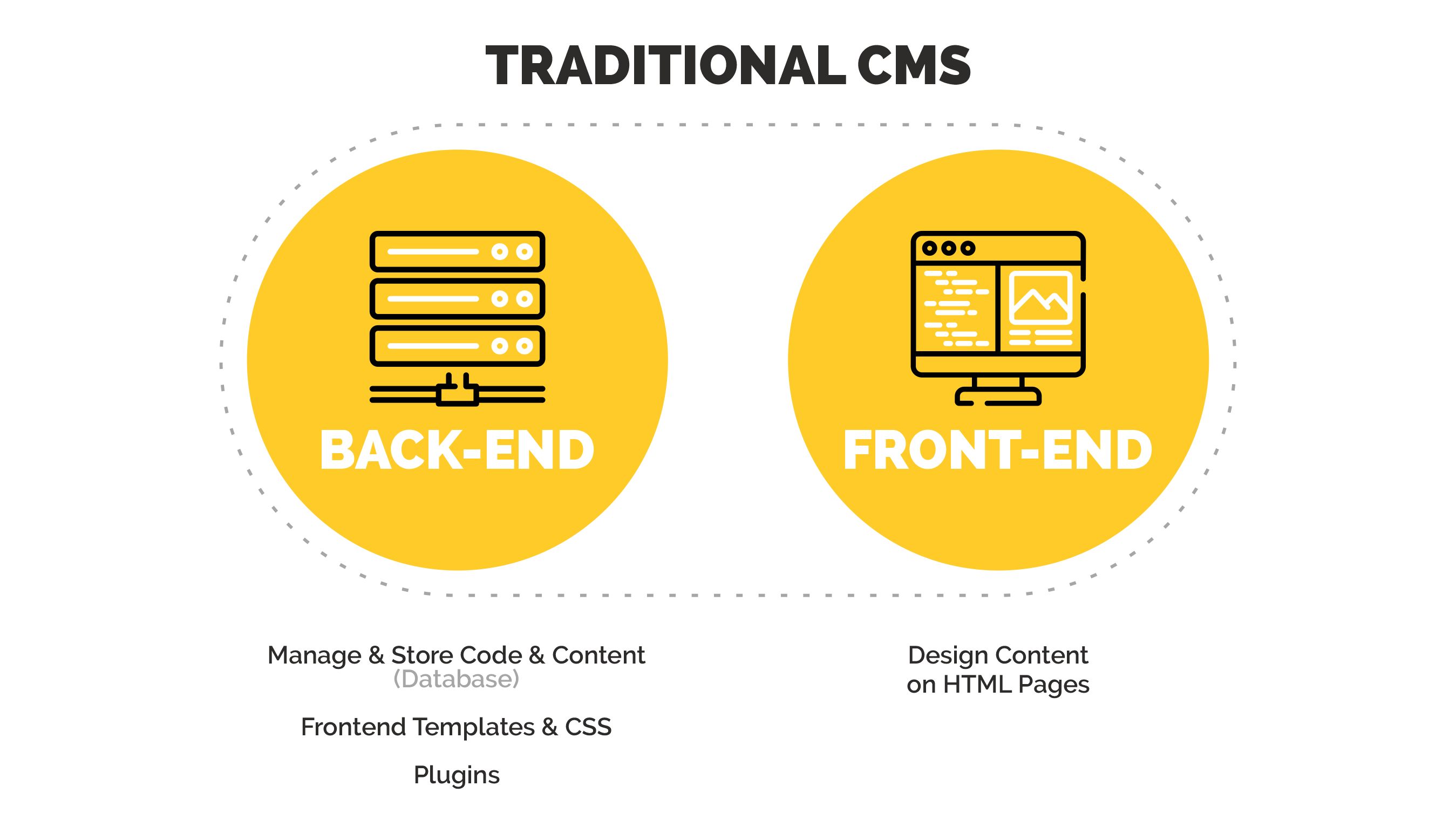
The caveats of Traditional CMS:
- Monolithic website architecture
- Set-it and forget-it content processes
- Bloated feature sets with a steep learning curve
Differences between Headless CMS vs Traditional CMS
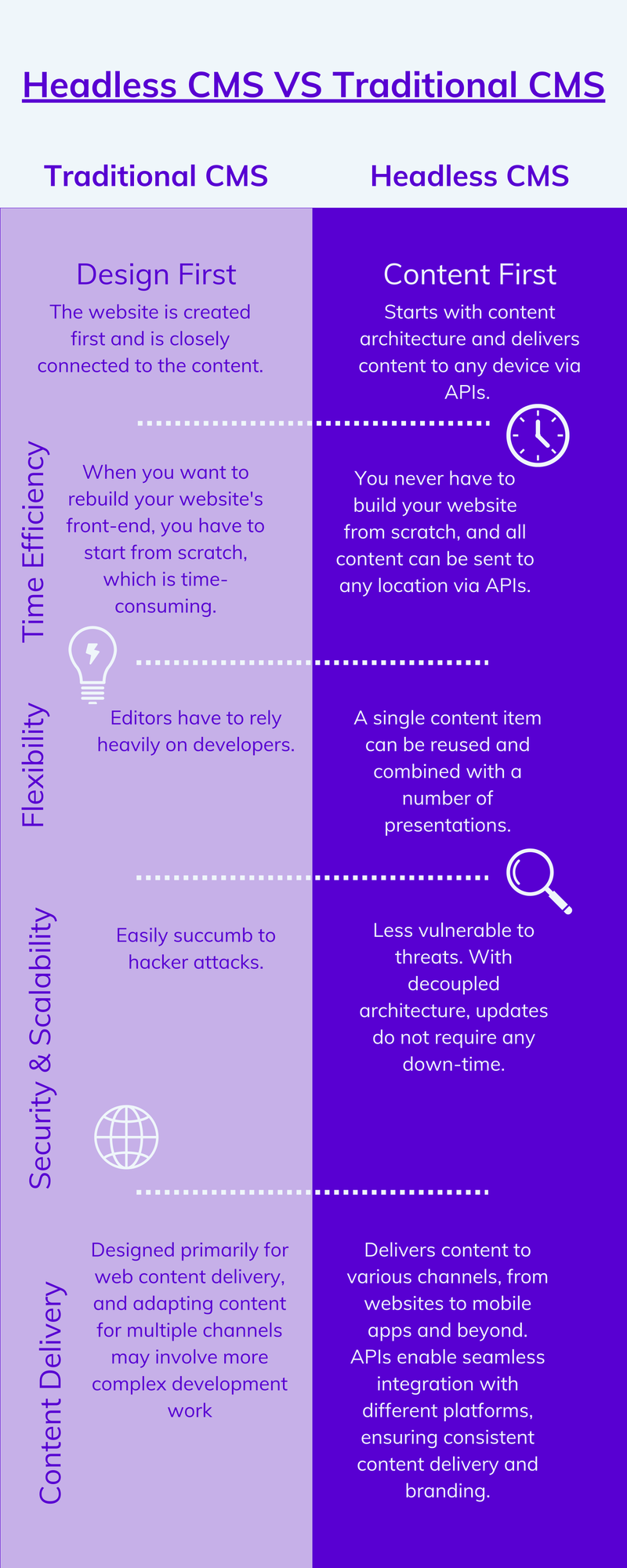
Content and Presentation Separation:
Headless CMS: In a headless CMS, content creation and management are decoupled from how the content is presented. The content repository (body) and the front-end display (head) are separate, allowing for greater flexibility in content delivery across various platforms.
Traditional CMS: Traditional CMS tightly integrates content creation and presentation. Content editors work within the same system that delivers content to users, limiting the ability to deliver content across diverse channels without significant customization.
Customization and Flexibility:
Headless CMS: With a headless CMS, you can design and customize the front-end experience as you see fit. This enables tailored user experiences for different devices and platforms.
Traditional CMS: While traditional CMS platforms offer customization options, they are often limited by predefined templates and themes. Customizing the presentation layer might require more effort and expertise.
Content Delivery to Multiple Channels:
Headless CMS: Headless CMS delivers content to various channels, from websites to mobile apps and beyond. APIs enable seamless integration with different platforms, ensuring consistent content delivery and branding.
Traditional CMS: Traditional CMS platforms are designed primarily for web content delivery, and adapting content for multiple channels may involve more complex development work.
Learning Curve:
Headless CMS: Using a headless CMS might involve a steeper learning curve for content editors accustomed to traditional CMS interfaces. Familiarity with API-driven content management is essential.
Traditional CMS: Traditional CMS platforms often feature user-friendly interfaces intuitive for non-technical users, requiring less training and adaptation.
Development Complexity:
Headless CMS: Implementing a headless CMS involves managing front-end development and API integration. With some headless CMS, this approach requires a skilled development team and can lead to higher initial development costs.
Traditional CMS: Traditional CMS platforms provide more integrated solutions, simplifying the development process. However, this might result in limited flexibility for advanced customization.
Scalability and Performance:
Headless CMS: Headless CMS architectures can be more scalable as content and presentation are separated. This allows for optimized performance and handling increased traffic or diverse user interactions.
Traditional CMS: Traditional CMS platforms might encounter scalability challenges due to their monolithic architecture, especially when dealing with complex features or high traffic volumes.
Time-to-Market:
Headless CMS: Implementing a headless CMS may require more time due to the need for custom front-end development and API integration.
Traditional CMS: Traditional CMS platforms often provide ready-to-use templates and themes, allowing for quicker deployment and faster time-to-market for basic websites.
In essence, the decision between a headless CMS and a traditional CMS hinges on your project's goals, technical requirements, and the extent of customization needed. Headless CMS offers versatile content delivery and modern capabilities, while traditional CMS platforms provide simplicity and familiarity for projects with less complex needs.
The Hedleass CMS Advantage:
Why is a headless CMS becoming so popular? Let’s dig into the top 10 reasons you should consider adopting a headless CMS solution for your business.
Headless CMS Benefits:
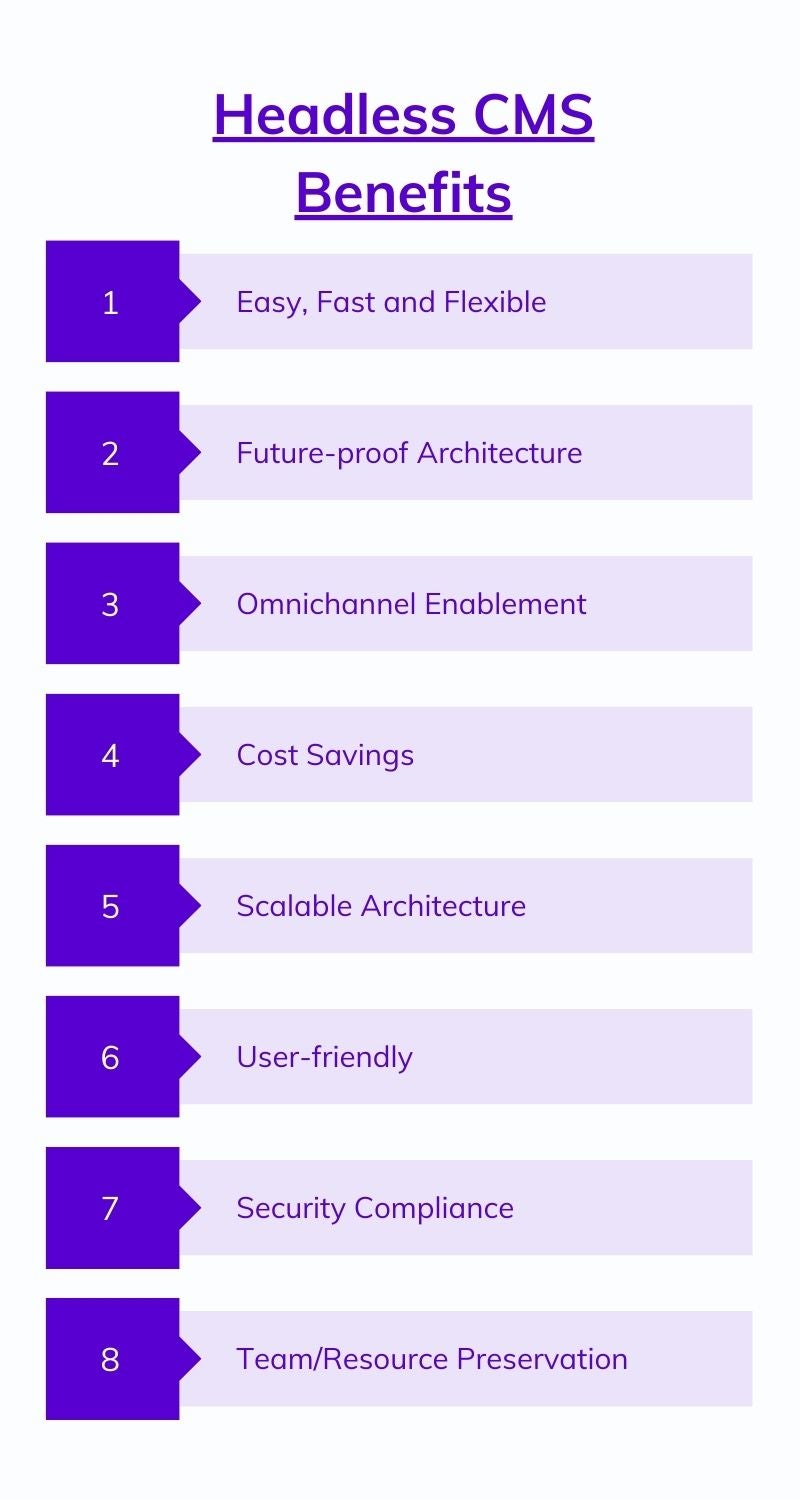
1. Headless CMS is easier, faster, and more flexible to develop on
You can pick your programming language, but a headless CMS is also API driven, so you can build your “head” (presentation layer/frontend) end to end.
Your developers can develop how they’re used to without conforming to any proprietary development constraints. A single content item can be reused and combined with several different presentation outputs, allowing for projects to be completed faster. A webhook is user-defined by an HTTP callback (or small code snippets linked to a web application) that trigger action-specific events.
A headless CMS allows easy and secure integrations with your existing systems. This includes the use of webhooks. A prime example of a webhook is triggering an email to your user once they have paid for a subscription on your site. Another benefit is not having a fixed structure to develop or code. This allows your developers to build any code for any type of integration. Not only will your developer love the flexibility it gives them just from a resourcing side but to integrate with more complex systems.
2. Headless CMS is future proof
A headless CMS allows you to future-proof your application by separating your presentation layer from your data and logic layer. It allows you to structure your content to make new projects easier for future-proofing as well as when re-branding one or more channels; there are no technical changes required within the CMS. Developers adopt the headless CMS approach to the parts of their existing stack where it makes sense. They carve out pieces and use APIs to make it all work together.
3. Headless CMS supports omnichannel architectures
Omnichannel can pose quite a challenge for marketers because they need to create iconic content that shines across all touchpoints. Instead of managing each channel separately, a headless CMS provides the ability to orchestrate a seamless experience that spans all touchpoints maintaining consistency and relevance. These challenges are compounded by the rising number of digital touchpoints and languages marketers must update in such a short period. A headless CMS removes those common barriers.
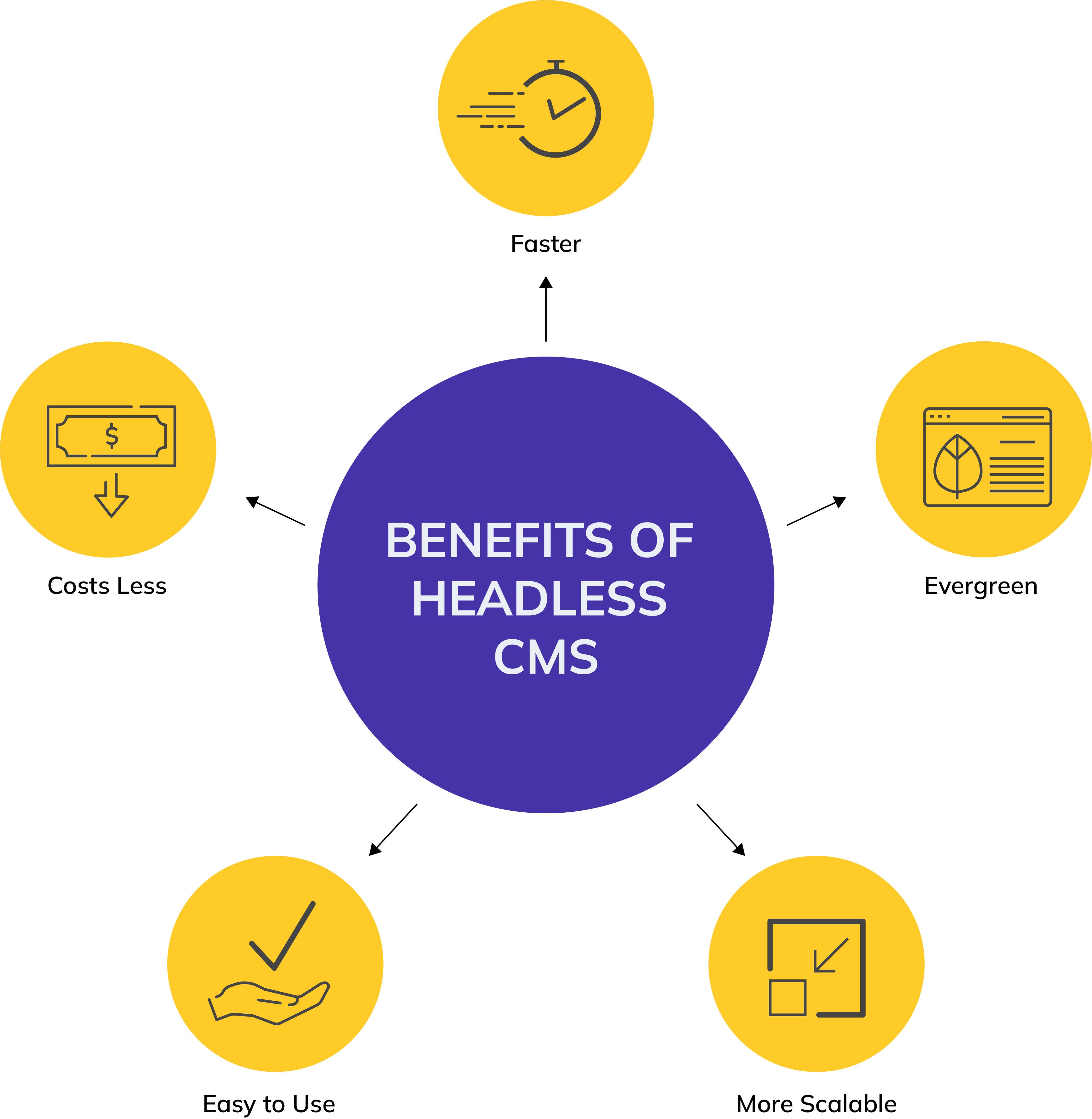
4. Headless CMS costs less
With little technical involvement required in a headless CMS, it’s much quicker for your business teams to create new functionality.
For example, suppose a marketing department wishes to create a new series of product mini-sites. In that case, they can go straight into the CMS and start creating immediately without waiting for developers to build CMS-based templates.
Your up-front cost is also diminished because you can start with smaller solutions and build your way up versus starting with one BIG install. It’s best to start small and then scale up as needed.
5. Headless CMS is more scalable
Since the back-end and front-end are separated, if the back-end CMS platform has any performance issues or needs maintenance, it won’t create downtime to your website or compromise its performance. Your hosting options are unlimited with a headless CMS and deployment environments.
6. Headless CMS is easier to learn and use
Many will agree that the biggest benefit of a headless CMS is how easy and fast it is to manage your content. The CMS implementation is cleaner, meaning the CMS tool is purely for storing content and isn’t cluttered with “stuff” that’s irrelevant to business users and other resources.
7. Headless CMS is evergreen (always up to date)
A huge benefit of a true, headless, multi-tenant system is that it's fully managed and upgraded for you. This is a huge benefit because upgrading can often be a costly project, not to mention that it's not very fun either so your team will be very happy to hear this benefit!
8. Headless CMS leads to better software architecture
A headless CMS provides better software architecture. A headless CMS is typically architected so that the CMS platform and the published content are separated. There are a huge number of benefits to this, including:
- Security: Access to the CMS is restructured internally within the organization, while content published outside is either approved for public consumption or can be secured/encrypted as required.
- Scalability: Need to add more servers to prop up demand for a particular application? Simply spin up a new app server and point it to the content.
- Availability: Should the CMS application go offline, there’s no impact on the web applications.
9. Headless CMS allows for a smaller, less specialized team
Companies no longer need large (and expensive) teams of specialist consultants knowledgeable in a particular CMS. Sure, some expertise is required, but not at the scale of a traditional CMS.
10. Headless CMS allows you to focus on your business
Spending all your time worrying about your CMS can take your attention away from growing your business. A traditional CMS can take away a lot of your precious resources.
Redefining Content Management with Headless CMS+: The Agility CMS Approach
Headless CMS+ represents a new era of content management that expands beyond traditional models.
At its core, it combines the flexibility of headless architecture with advanced features for enhanced performance. As exemplified by Agility CMS, a leading Headless CMS+ platform, it introduces several differentiators:
Layout Management:
Unlike typical headless CMS systems, Agility CMS introduces layouts, enabling effortless page structuring without compromising decoupling principles. This empowers content editors to create engaging layouts while maintaining the flexibility of the headless architecture.
Complex Content Handling:
Agility CMS goes beyond basic content types, seamlessly managing intricate content structures and relationships. Agility CMS handles diverse content scenarios effortlessly from interconnected content modules to multi-level navigation.
White Glove Service:
Agility CMS offers dedicated white glove service, ensuring personalized support throughout your journey. This unique approach minimizes hurdles and maximizes the effectiveness of adopting and using the platform.
Agility CMS+: Elevating Content Management Excellence
By embracing these differentiators, Agility CMS embodies the essence of Headless CMS+. It empowers developers with unmatched customization capabilities, streamlines content editing workflows, and facilitates intricate content management. As businesses strive to deliver exceptional digital experiences, Agility CMS stands as a testament to the power of Headless CMS+ in transforming content management into a dynamic and user-centric practice.
Categories
GuideGuide
Topics
Headless CMSHeadless CMS
Dive into Headless CMS & Content Architecture
Ready to see Agility CMS in action?
Get in touch with our friendly experts
